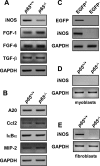NF-kappaB functions in stromal fibroblasts to regulate early postnatal muscle development
- PMID: 20018862
- PMCID: PMC2820776
- DOI: 10.1074/jbc.M109.075606
NF-kappaB functions in stromal fibroblasts to regulate early postnatal muscle development
Abstract
Classical NF-kappaB activity functions as an inhibitor of the skeletal muscle myogenic program. Recent findings reveal that even in newborn RelA/p65(-/-) mice, myofiber numbers are increased over that of wild type mice, suggesting that NF-kappaB may be a contributing factor in early postnatal skeletal muscle development. Here we show that in addition to p65 deficiency, repression of NF-kappaB with the IkappaB alpha-SR transdominant inhibitor or with muscle-specific deletion of IKKbeta resulted in similar increases in total fiber numbers as well as an up-regulation of myogenic gene products. Upon further characterization of early postnatal muscle, we observed that NF-kappaB activity progressively declines within the first few weeks of development. At birth, the majority of this activity is compartmentalized to muscle fibers, but by neonatal day 8 NF-kappaB activity from the myofibers diminishes, and instead, stromal fibroblasts become the main cellular compartment within the muscle that contains active NF-kappaB. We find that NF-kappaB functions in these fibroblasts to regulate inducible nitric-oxide synthase expression, which we show is important for myoblast fusion during the growth and maturation process of skeletal muscle. Together, these data broaden our understanding of NF-kappaB during development by showing that in addition to its role as a negative regulator of myogenesis, NF-kappaB also regulates nitric-oxide synthase expression within stromal fibroblasts to stimulate myoblast fusion and muscle hypertrophy.
Figures








Similar articles
-
IKK/NF-kappaB regulates skeletal myogenesis via a signaling switch to inhibit differentiation and promote mitochondrial biogenesis.J Cell Biol. 2008 Feb 25;180(4):787-802. doi: 10.1083/jcb.200707179. J Cell Biol. 2008. PMID: 18299349 Free PMC article.
-
Canonical NF-κB signaling regulates satellite stem cell homeostasis and function during regenerative myogenesis.J Mol Cell Biol. 2019 Jan 1;11(1):53-66. doi: 10.1093/jmcb/mjy053. J Mol Cell Biol. 2019. PMID: 30239789
-
NF-κB negatively impacts the myogenic potential of muscle-derived stem cells.Mol Ther. 2012 Mar;20(3):661-8. doi: 10.1038/mt.2011.261. Epub 2011 Dec 13. Mol Ther. 2012. PMID: 22158056 Free PMC article.
-
NF-kappaB signaling: a tale of two pathways in skeletal myogenesis.Physiol Rev. 2010 Apr;90(2):495-511. doi: 10.1152/physrev.00040.2009. Physiol Rev. 2010. PMID: 20393192 Review.
-
Reining in nuclear factor-kappaB in skeletal muscle disorders.Curr Opin Clin Nutr Metab Care. 2013 May;16(3):251-7. doi: 10.1097/MCO.0b013e3283600e79. Curr Opin Clin Nutr Metab Care. 2013. PMID: 23493016 Review.
Cited by
-
Connective tissue fibroblasts and Tcf4 regulate myogenesis.Development. 2011 Jan;138(2):371-84. doi: 10.1242/dev.057463. Development. 2011. PMID: 21177349 Free PMC article.
-
Signaling mechanisms in mammalian myoblast fusion.Sci Signal. 2013 Apr 23;6(272):re2. doi: 10.1126/scisignal.2003832. Sci Signal. 2013. PMID: 23612709 Free PMC article. Review.
-
NF-κB-mediated Pax7 dysregulation in the muscle microenvironment promotes cancer cachexia.J Clin Invest. 2013 Nov;123(11):4821-35. doi: 10.1172/JCI68523. J Clin Invest. 2013. PMID: 24084740 Free PMC article.
-
The Role of Supporting Cell Populations in Satellite Cell Mediated Muscle Repair.Cells. 2023 Jul 30;12(15):1968. doi: 10.3390/cells12151968. Cells. 2023. PMID: 37566047 Free PMC article. Review.
-
Transcriptional Factor NF-κB as a Target for Therapy in Parkinson's Disease.Parkinsons Dis. 2011;2011:216298. doi: 10.4061/2011/216298. Epub 2011 Mar 30. Parkinsons Dis. 2011. PMID: 21603248 Free PMC article.
References
-
- Baeuerle P. A., Baltimore D. (1996) Cell 87, 13–20 - PubMed
-
- Baldwin A. S., Jr. (1996) Annu. Rev. Immunol. 14, 649–683 - PubMed
-
- Verma I. M., Stevenson J. K., Schwarz E. M., Van Antwerp D., Miyamoto S. (1995) Genes Dev. 9, 2723–2735 - PubMed
-
- Hayden M. S., Ghosh S. (2004) Genes Dev. 18, 2195–2224 - PubMed
Publication types
MeSH terms
Substances
Grants and funding
LinkOut - more resources
Full Text Sources
Molecular Biology Databases
Research Materials

